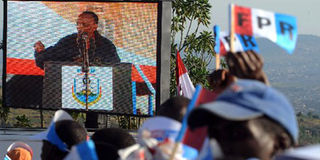Kagame mania peaks as voters in massive show of support at rally

Supporters of Rwandan President Paul Kagame watch as he addresses a rally at the Gasavo vumbungo on the last day of the presidential rally ahead of Monday's presidential election on August 7, 2010 in Kigali. AFP|Nation
To a crescendo of “We will vote for you!” and “No one but you!”, Rwandan President Paul Kagame made his final campaign appearance before Monday’s poll like a long-awaited rock star.
In his campaign, Mr Kagame employed SMS, tweeting and facebooking updates of his manifesto. On his official website Mr Kagame said in a statement, “For those who wonder why I have chosen to run again, you must not know that challenges have never stopped me.”
Rwanda goes to polls with the shortest campaigning period (not more than 20 days) registered amongst all the five East African states. With just days to the end of elections there is still no single incident of election violence and no mention of ethnicities or religion.
Rwanda goes to polls to with four presidential candidates including Alvera Mukabaramba the only female candidate, whose is a non-practising medical doctor, representing the Party for Progressive Concord a small party with no seat in Rwanda’s bicameral parliaments.
Other than President Kagame, Dr Ntawukuliryayo and Mukabaramba, Mr Prosper Higiro is another candidate representing the Liberal Party which claims four seats in parliament.
At his final rally on Saturday, President Kagame faced a sea of paraphernalia in his party colours of red, white and blue: umbrellas, flags, caps, T-shirts stretching as far as the eye could see.
Supporters of the Rwandan Patriotic Front (RPF) have over the past weeks donned tunics sewn from RPF scarves, sported wigs and body paint in the party colours and even built a three-wheel “Kagamemobile” from a wheelbarrow.
Even the trees lining the road leading to the rally venue were wrapped in red, white and blue for Kagame who is virtually assured of victory.
This year’s campaign poster shows Mr Kagame as slightly more mellow than in the official portrait. Nothing deters the supporters: some are heavily pregnant, others bent double with age, some are on crutches or pushed in wheelchairs by their grandchildren.
They come in on foot, by the busload or perched precariously on the top of trucks.
A giant screen mounted on an RPF truck alternates images of Kagame sporting a baseball cap and those of the crowd dancing feverishly, arms aloft, punching the air, seemingly oblivious to the hours of waiting in the hot sun.
Singers encourage the crowd to expend yet more energy.
A poet recites a homage to Kagame. A party activist tells how her life was changed by the RPF, saying that since he came to power, women have gained their place in Rwandan politics.
“Rwanda’s new politics are not the politics of the Hutu, the Tutsi or the Twa but the politics of all Rwandans,” President Kagame said, referring to the country’s main ethnic groups.
Kagame was just 36 in 1994 when the RPF rebel army routed genocidal forces who had killed an estimated 800,000 people and he took power in Rwanda.
“The justice I have put in place is for all Rwandans, the education system for all Rwandans,” he said.
“It’s in part love for Paul (Kagame), in part the phenomenon you see with born again Christians where one person goes so they all go and in part local leaders encouraging people to go,” commented one observer.
The only world leader known to have undergone military training both in the US and in Cuba, Kagame is criticised for being dictatorial.
“Kagame allows less political space and press freedom at home than Robert Mugabe does in Zimbabwe,” The Economist charged recently. “Before 1998 Kagame could count on almost unlimited sympathy from the international community, which felt guilty for its neglect during the genocide. Today, his moral credit has been seriously damaged by the horrors committed in the Congo during 1998-2003,” writes Gerard Prunier, a French academic.




